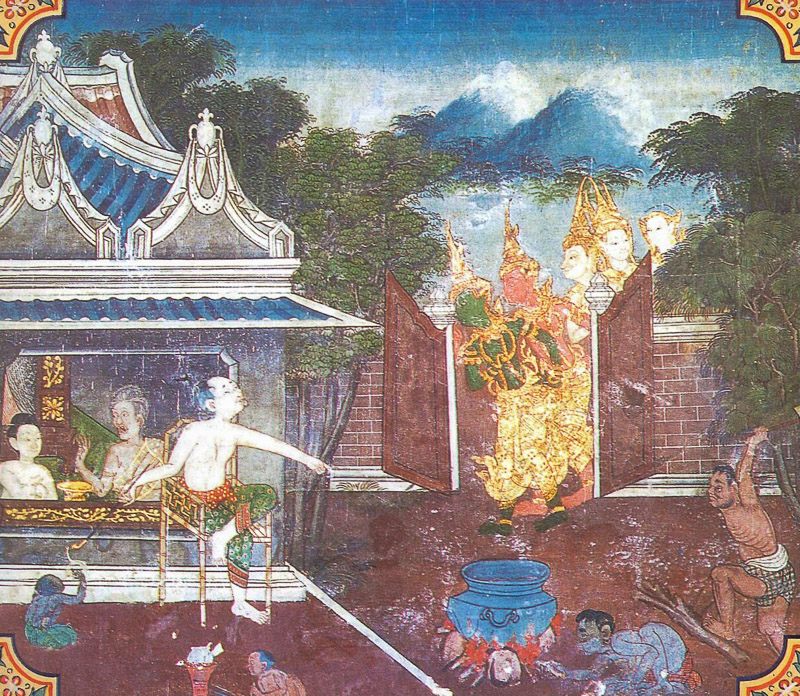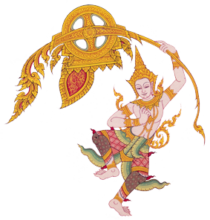
The Bodhisatta was once Indra, king of the gods. In his earthly life before this, he worked as the king’s treasurer and was exceptionally wealthy. One day he pondered his life and realized he had earned his prosperity through living a virtuous life, and he felt now was the time to take it to the next level by giving away his fortune. He offered everything to the king, but he said he was already rich enough. So the Bodhisatta built six alms halls around the city and gave money to the poor every day for the rest of his life. Before he died and became Indra, he instructed his son to continue giving away money, and he did. And so did the next three generations of his sons. And for their virtue, when born in heaven these four men became Chandra, the moon god; Surya, the sun god; Matali, Indra’s charioteer; and Pancasikha, one of heaven’s top musicians. But the next in the line, Kosiya (known as Maccharikosiya, the “Millionaire Miser”), felt that his forefathers were fools and he hoarded the remainder of the family fortune, neither helping the poor nor spending any more than absolutely necessary. He wore coarse clothes, shaded his head with leaves, and rode in a crazy old chariot yoked to worn-out oxen.
One morning, Kosiya saw his assistant eating sweetened rice porridge. He invited Kosiya to join him, but he refused so he wouldn’t ever need to return the hospitality. But he got a deep craving for it that lasted days because he would not “waste” the money to eat some, and his unmet desire made him grow weak and pale. Finally, unable to bear it any longer, Kosiya had his wife prepare the ingredients, and he took them to the forest where he could cook and eat in secret: if he cooked in his house, others would know about it and want some. He snuck out of his house in disguise and had one of his slaves keep watch near his forest hideout as he cooked so nobody would ask for some.
Meanwhile, just at that moment, the Bodhisatta sat in his heavenly abode and wondered what had become of his descendants. He divined that those who had already died had been reborn in heaven, but his great-great-great-grandson was a wicked man destined for hell. He assembled his other four relatives and they went down to earth to put the miser on the right path. They took the forms of brahmins and one by one approached Kosiya asking for porridge. Kosiya insulted the Bodhisatta, who went first, and told him to go away. But when the Bodhisatta spoke wise words about how generosity leads to salvation, Kosiya agreed to share a little. The next four brahmins approached, and in the same manner were begrudgingly invited to eat.
When the porridge was ready, Kosiya told the brahmins to use small leaf bowls for eating because there was not enough porridge for six people. But their small leaves magically grew to the size of warrior shields, and yet there was still porridge left over after they had all been served.
Before they ate, the brahmin who had been Kosiya’s father transformed into a dog and urinated into the pot. Kosiya grabbed a stick to hit the dog, but then the dog switched into a thoroughbred horse that changed colors and size. The other brahmins rose into the air and watched it chase after Kosiya. As he ran in fear, Kosiya shouted out, “Who are you people?” The Bodhisatta revealed their true identities and said they came with pity and compassion to save him from hell. The Bodhisatta then sat with Kosiya and explained how heavenly glory was earned only by the generous and the righteous. Kosiya accepted his lesson and promised to change his ways. Having established Kosiya in righteousness, the Bodhisatta and the other gods returned to heaven. Kosiya immediately met with the king and arranged to have his family’s riches given to the poor once again. Then he walked into the forest to live as an ascetic in a leaf hut along the Ganges River.
In heaven, the Bodhisatta had four divine daughters. One day a brahmin ascetic visited Indra’s heaven, and these four nymphs saw him using a magical paricchattaka flower as a parasol. They all wanted it. This ascetic said he had no attachment to it and would give it to whichever of the daughters was the best. Indra did not want to choose, thus making three of his daughters angry, so he said Kosiya would do it. He sent Matali to take some ambrosia to Kosiya and give him his task; then the daughters appeared at the four compass points. After a brief conversation with each, Kosiya chose one as the most virtuous and shared his special food with her alone. Moments later, while explaining the reason for his choice to Matali, Kosiya died and was reborn in Indra’s heaven. The Bodhisatta was so glad to see Kosiya that he gave him his chosen daughter to be his chief wife.
In the Lifetime of the Buddha
Kosiya was an earlier birth of one of the Buddha’s disciples who was exemplary in conduct and devoted to charity. All the alms he received he shared with other disciples. When the Buddha heard some of his other disciples discussing this disciple’s immense generosity, he told them this story so they knew that in the past this disciple had once been so stingy he would not even give anyone so much as a drop of oil from the top of a blade of grass, and the Buddha had also converted him back then.
The descendants of the Bodhisatta who came before Kosiya were earlier births of Moggallana, Maha Kassapa, Ananda, and Anuruddha, four of the Buddha’s top disciples. The ascetic with the paricchattaka flower and the chosen daughter were earlier births of Sariputta and Uppalavanna, two more top disciples.
